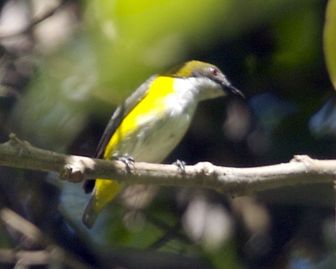Yellow-sided Flowerpecker
Its natural habitats are subtropical or tropical moist lowland forests and subtropical or tropical moist montane forests.

Original source: Lip Kee YapPermission(Reusing this file)This image, which was originally posted to Flickr.com, was uploaded to Commons using Flickr upload bot on 01:40, 6 April 2009 (UTC) by Rufous-crowned Sparrow (talk). On that date it was licensed under the license below. This file is licensed under the Creative Commons Attribution-Share Alike 2.0 Generic license.You are free:to share – to copy, distribute and transmit the work
Author: Lip Kee YapPermission(Reusing this file)This image, which was originally posted to Flickr.com, was uploaded to Commons using Flickr upload bot on 01:40, 6 April 2009 (UTC) by Rufous-crowned Sparrow (talk). On that date it was licensed under the license below. This file is licensed under the Creative Commons Attribution-Share Alike 2.0 Generic license.You are free:to share – to copy, distribute and transmit the work
The Yellow-sided Flowerpecker is classified as Least Concern. Does not qualify for a more at risk category. Widespread and abundant taxa are included in this category.
The Yellow-sided Flowerpecker is a species of bird in the Dicaeidae family. Yellow-vented Flowerpecker - The Yellow-vented Flowerpecker is a species of bird in the Dicaeidae family. More
The Yellow-sided Flowerpecker (Dicaeum aureolimbatum) is a species of bird in the Dicaeidae family. It is endemic to Sulawesi and adjacent islands in Indonesia. Its natural habitats are subtropical or tropical moist lowland forests and subtropical or tropical moist montane forests. References - * BirdLife International 2004. Dicaeum aureolimbatum. 2006 IUCN Red List of Threatened Species. Downloaded on 25 July 2007. More
* Yellow-sided Flowerpecker Dicaeum aureolimbatum: The commonest of the flowerpeckers on Sulawesi. * Crimson-crowned Flowerpecker Dicaeum nehrkorni: Some great views of this bright species in Lore Lindu. Crimson-crowned Flowerpecker * Flame-breasted Flowerpecker Dicaeum erythrothorax: Just one for most but fortunately it was a male that showed well along the logging track on Halmahera. More
Yellow-sided Flowerpecker ( Dicaeum aureolimbatum ) : This is a tiny flowerpecker measuring only about 8 to 8,5 cm, endemic to Sulawesi and nearby islands. The diet is mainly small figs, berries, polen and small insects. A common species in it More
View all pictures of Yellow-sided Flowerpecker View all pictures of Yellow-sided Flowerpecker show section External Links (0) We currently have no external links for this species. More
The Yellow-sided Flowerpecker is endemic to Sulawesi and a few neighbouring islands where two subspecies can be found D. laterale and D. aureolimbatum (Coates, 1997). Throughout Sulawesi the species is widespread and common inhabiting a wide range of habitats including primary and secondary forest, forest edge, scrub, plantations and lightly wooded cultivation. On Buton it is also common in overgrown plantations and in village gardens but it appears to be most common in forested habitats (Watling, 1983). More
Family : Dicaeidae
Genus : Dicaeum
Species : aureolimbatum
Authority : (Wallace, 1865)
